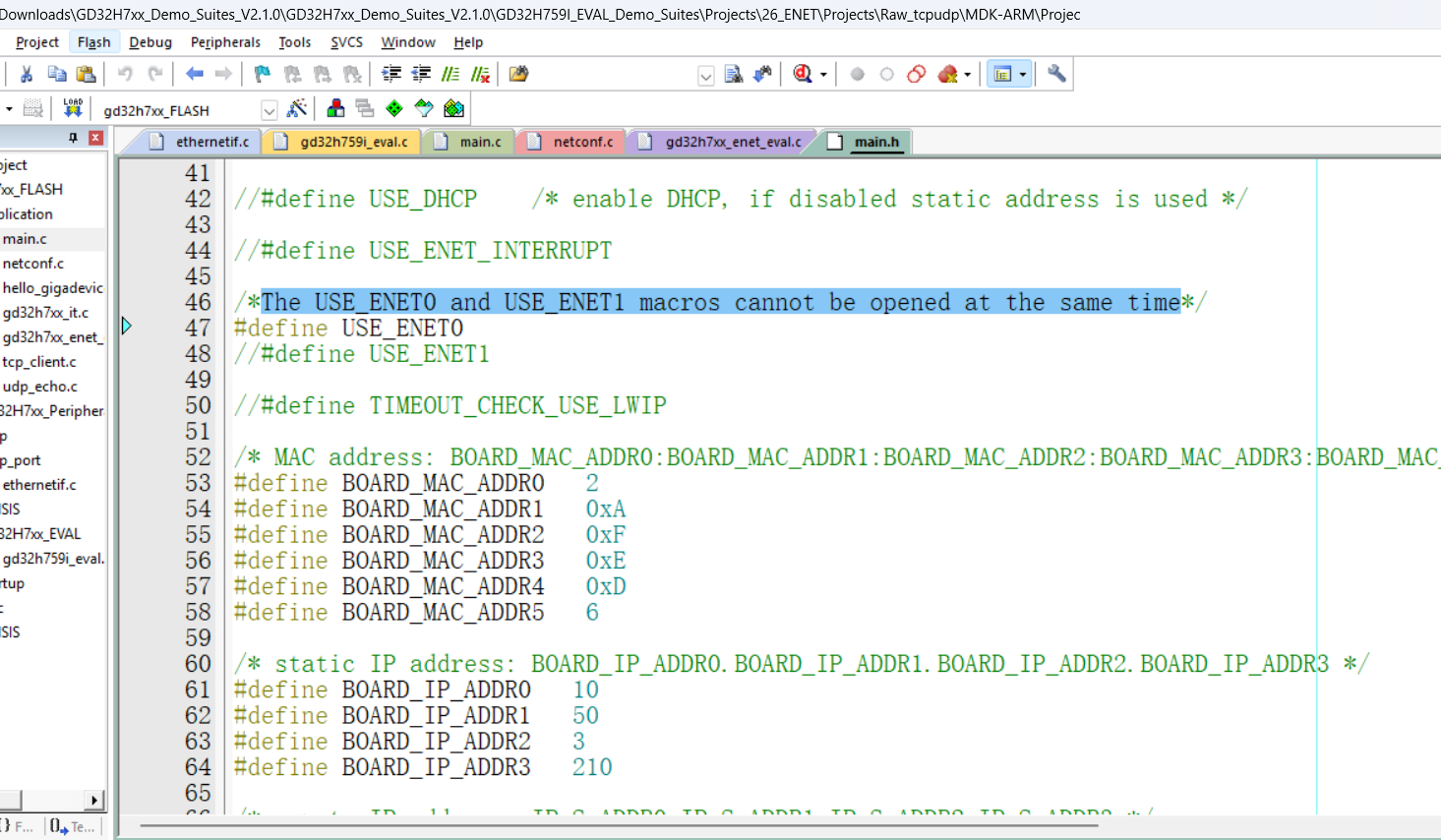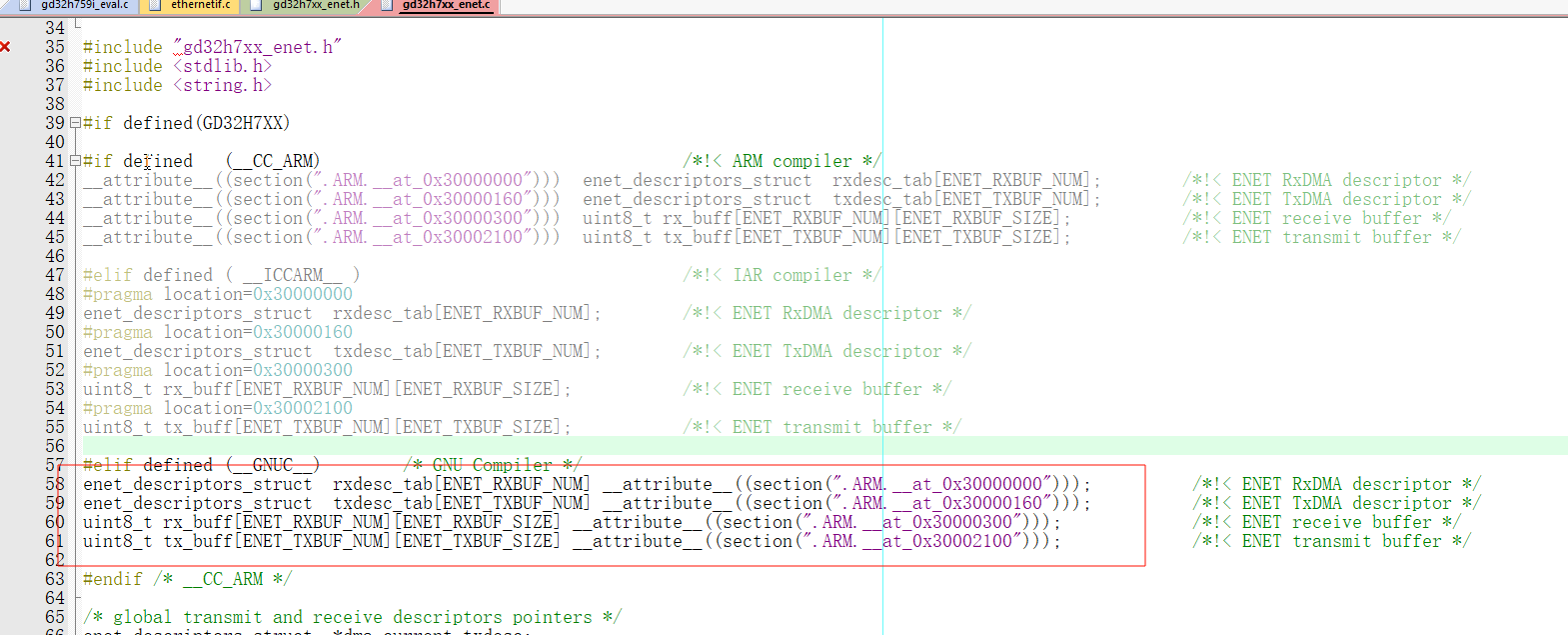[C] 纯文本查看 复制代码
/**
* @file
* Ethernet Interface for standalone applications (without RTOS)
*
*/
/*
Mac地址分为2个,网段也不一样了,两个网卡分别初始化
* Copyright (c) 2001-2004 Swedish Institute of Computer Science.
* All rights reserved.
*
* Redistribution and use in source and binary forms, with or without modification,
* are permitted provided that the following conditions are met:
*
* 1. Redistributions of source code must retain the above copyright notice,
* this list of conditions and the following disclaimer.
* 2. Redistributions in binary form must reproduce the above copyright notice,
* this list of conditions and the following disclaimer in the documentation
* and/or other materials provided with the distribution.
* 3. The name of the author may not be used to endorse or promote products
* derived from this software without specific prior written permission.
*
* THIS SOFTWARE IS PROVIDED BY THE AUTHOR ``AS IS'' AND ANY EXPRESS OR IMPLIED
* WARRANTIES, INCLUDING, BUT NOT LIMITED TO, THE IMPLIED WARRANTIES OF
* MERCHANTABILITY AND FITNESS FOR A PARTICULAR PURPOSE ARE DISCLAIMED. IN NO EVENT
* SHALL THE AUTHOR BE LIABLE FOR ANY DIRECT, INDIRECT, INCIDENTAL, SPECIAL,
* EXEMPLARY, OR CONSEQUENTIAL DAMAGES (INCLUDING, BUT NOT LIMITED TO, PROCUREMENT
* OF SUBSTITUTE GOODS OR SERVICES; LOSS OF USE, DATA, OR PROFITS; OR BUSINESS
* INTERRUPTION) HOWEVER CAUSED AND ON ANY THEORY OF LIABILITY, WHETHER IN
* CONTRACT, STRICT LIABILITY, OR TORT (INCLUDING NEGLIGENCE OR OTHERWISE) ARISING
* IN ANY WAY OUT OF THE USE OF THIS SOFTWARE, EVEN IF ADVISED OF THE POSSIBILITY
* OF SUCH DAMAGE.
*
* This file is part of the lwIP TCP/IP stack.
*
* Author: Adam Dunkels <[email]adam@sics.se[/email]>
*
*/
#include "lwip/mem.h"
#include "netif/etharp.h"
#include "ethernetif.h"
#include "gd32h7xx_enet.h"
#include "main.h"
#include <string.h>
/* network interface name */
#define IFNAME0 'G'
#define IFNAME1 'D'
/* ENET RxDMA/TxDMA descriptor */
extern enet_descriptors_struct rxdesc_tab[ENET_RXBUF_NUM], txdesc_tab[ENET_TXBUF_NUM];
/* ENET receive buffer */
extern uint8_t rx_buff[ENET_RXBUF_NUM][ENET_RXBUF_SIZE];
/* ENET transmit buffer */
extern uint8_t tx_buff[ENET_TXBUF_NUM][ENET_TXBUF_SIZE];
/*global transmit and receive descriptors pointers */
extern enet_descriptors_struct *dma_current_txdesc;
extern enet_descriptors_struct *dma_current_rxdesc;
/* preserve another ENET RxDMA/TxDMA ptp descriptor for normal mode */
enet_descriptors_struct ptp_txstructure[ENET_TXBUF_NUM];
enet_descriptors_struct ptp_rxstructure[ENET_RXBUF_NUM];
/**
* In this function, the hardware should be initialized.
* Called from ethernetif_init().
*
* @param netif the already initialized lwip network interface structure
* for this ethernetif
*/
static void low_level_init0(struct netif *netif)
{
#ifdef CHECKSUM_BY_HARDWARE
int i;
#endif /* CHECKSUM_BY_HARDWARE */
/* set MAC hardware address length */
netif->hwaddr_len = ETHARP_HWADDR_LEN;
/* set MAC hardware address */
netif->hwaddr[0] = MAC_ADDR0_A;
netif->hwaddr[1] = MAC_ADDR1_A;
netif->hwaddr[2] = MAC_ADDR2_A;
netif->hwaddr[3] = MAC_ADDR3_A;
netif->hwaddr[4] = MAC_ADDR4_A;
netif->hwaddr[5] = MAC_ADDR5_A;
#ifdef USE_ENET0
/* initialize MAC address in ethernet MAC */
enet_mac_address_set(ENET0, ENET_MAC_ADDRESS0, netif->hwaddr);
#endif /* USE_ENET0 */
/* maximum transfer unit */
netif->mtu = 1500;
/* device capabilities */
/* don't set NETIF_FLAG_ETHARP if this device is not an ethernet one */
netif->flags = NETIF_FLAG_BROADCAST | NETIF_FLAG_ETHARP | NETIF_FLAG_LINK_UP;
#ifdef USE_ENET0
/* initialize descriptors list: chain/ring mode */
#ifdef SELECT_DESCRIPTORS_ENHANCED_MODE
enet_ptp_enhanced_descriptors_chain_init(ENET0, ENET_DMA_TX);
enet_ptp_enhanced_descriptors_chain_init(ENET0, ENET_DMA_RX);
#else
enet_descriptors_chain_init(ENET0, ENET_DMA_TX);
enet_descriptors_chain_init(ENET0, ENET_DMA_RX);
// enet_descriptors_ring_init(ENET0, ENET_DMA_TX);
// enet_descriptors_ring_init(ENET0, ENET_DMA_RX);
#endif /* SELECT_DESCRIPTORS_ENHANCED_MODE */
#endif /* USE_ENET0 */
/* enable ethernet Rx interrrupt */
{
int i;
for(i = 0; i < ENET_RXBUF_NUM; i++) {
enet_rx_desc_immediate_receive_complete_interrupt(&rxdesc_tab[i]);
}
}
#ifdef CHECKSUM_BY_HARDWARE
/* enable the TCP, UDP and ICMP checksum insertion for the Tx frames */
for(i = 0; i < ENET_TXBUF_NUM; i++) {
enet_transmit_checksum_config(&txdesc_tab[i], ENET_CHECKSUM_TCPUDPICMP_FULL);
}
#endif /* CHECKSUM_BY_HARDWARE */
/* note: TCP, UDP, ICMP checksum checking for received frame are enabled in DMA config */
#ifdef USE_ENET0
/* enable MAC and DMA transmission and reception */
enet_enable(ENET0);
#endif /* USE_ENET0 */
}
static void low_level_init1(struct netif *netif)
{
#ifdef CHECKSUM_BY_HARDWARE
int i;
#endif /* CHECKSUM_BY_HARDWARE */
/* set MAC hardware address length */
netif->hwaddr_len = ETHARP_HWADDR_LEN;
/* set MAC hardware address */
netif->hwaddr[0] = MAC_ADDR0_B;
netif->hwaddr[1] = MAC_ADDR1_B;
netif->hwaddr[2] = MAC_ADDR2_B;
netif->hwaddr[3] = MAC_ADDR3_B;
netif->hwaddr[4] = MAC_ADDR4_B;
netif->hwaddr[5] = MAC_ADDR5_B;
#ifdef USE_ENET1
/* initialize MAC address in ethernet MAC */
enet_mac_address_set(ENET1, ENET_MAC_ADDRESS0, netif->hwaddr);
#endif /* USE_ENET1 */
/* maximum transfer unit */
netif->mtu = 1500;
/* device capabilities */
/* don't set NETIF_FLAG_ETHARP if this device is not an ethernet one */
netif->flags = NETIF_FLAG_BROADCAST | NETIF_FLAG_ETHARP | NETIF_FLAG_LINK_UP;
#ifdef USE_ENET1
/* initialize descriptors list: chain/ring mode */
#ifdef SELECT_DESCRIPTORS_ENHANCED_MODE
enet_ptp_enhanced_descriptors_chain_init(ENET1, ENET_DMA_TX);
enet_ptp_enhanced_descriptors_chain_init(ENET1, ENET_DMA_RX);
#else
enet_descriptors_chain_init(ENET1, ENET_DMA_TX);
enet_descriptors_chain_init(ENET1, ENET_DMA_RX);
// enet_descriptors_ring_init(ENET1, ENET_DMA_TX);
// enet_descriptors_ring_init(ENET1, ENET_DMA_RX);
#endif /* SELECT_DESCRIPTORS_ENHANCED_MODE */
#endif /* USE_ENET1 */
/* enable ethernet Rx interrrupt */
{
int i;
for(i = 0; i < ENET_RXBUF_NUM; i++) {
enet_rx_desc_immediate_receive_complete_interrupt(&rxdesc_tab[i]);
}
}
#ifdef CHECKSUM_BY_HARDWARE
/* enable the TCP, UDP and ICMP checksum insertion for the Tx frames */
for(i = 0; i < ENET_TXBUF_NUM; i++) {
enet_transmit_checksum_config(&txdesc_tab[i], ENET_CHECKSUM_TCPUDPICMP_FULL);
}
#endif /* CHECKSUM_BY_HARDWARE */
/* note: TCP, UDP, ICMP checksum checking for received frame are enabled in DMA config */
#ifdef USE_ENET1
/* enable MAC and DMA transmission and reception */
enet_enable(ENET1);
#endif /* USE_ENET1 */
}
/**
* This function should do the actual transmission of the packet. The packet is
* contained in the pbuf that is passed to the function. This pbuf
* might be chained.
*
* @param netif the lwip network interface structure for this ethernetif
* @param p the MAC packet to send (e.g. IP packet including MAC addresses and type)
* @return ERR_OK if the packet could be sent
* an err_t value if the packet couldn't be sent
*
* @note Returning ERR_MEM here if a DMA queue of your MAC is full can lead to
* strange results. You might consider waiting for space in the DMA queue
* to become availale since the stack doesn't retry to send a packet
* dropped because of memory failure (except for the TCP timers).
*/
static err_t low_level_output0(struct netif *netif, struct pbuf *p)
{
struct pbuf *q;
int framelength = 0;
uint8_t *buffer;
while((uint32_t)RESET != (dma_current_txdesc->status & ENET_TDES0_DAV)) {
}
buffer = (uint8_t *)(enet_desc_information_get(ENET0, dma_current_txdesc, TXDESC_BUFFER_1_ADDR));
/* copy frame from pbufs to driver buffers */
for(q = p; q != NULL; q = q->next) {
memcpy((uint8_t *)&buffer[framelength], q->payload, q->len);
framelength = framelength + q->len;
}
/* note: padding and CRC for transmitted frame
are automatically inserted by DMA */
/* transmit descriptors to give to DMA */
#ifdef SELECT_DESCRIPTORS_ENHANCED_MODE
ENET_NOCOPY_PTPFRAME_TRANSMIT_ENHANCED_MODE(ENET0, framelength, NULL);
#else
ENET_NOCOPY_FRAME_TRANSMIT(ENET0, framelength);
#endif /* SELECT_DESCRIPTORS_ENHANCED_MODE */
return ERR_OK;
}
static err_t low_level_output1(struct netif *netif, struct pbuf *p)
{
struct pbuf *q;
int framelength = 0;
uint8_t *buffer;
while((uint32_t)RESET != (dma_current_txdesc->status & ENET_TDES0_DAV)) {
}
buffer = (uint8_t *)(enet_desc_information_get(ENET1, dma_current_txdesc, TXDESC_BUFFER_1_ADDR));
/* copy frame from pbufs to driver buffers */
for(q = p; q != NULL; q = q->next) {
memcpy((uint8_t *)&buffer[framelength], q->payload, q->len);
framelength = framelength + q->len;
}
/* note: padding and CRC for transmitted frame
are automatically inserted by DMA */
/* transmit descriptors to give to DMA */
#ifdef SELECT_DESCRIPTORS_ENHANCED_MODE
ENET_NOCOPY_PTPFRAME_TRANSMIT_ENHANCED_MODE(ENET1, framelength, NULL);
#else
ENET_NOCOPY_FRAME_TRANSMIT(ENET1, framelength);
#endif /* SELECT_DESCRIPTORS_ENHANCED_MODE */
return ERR_OK;
}
/**
* Should allocate a pbuf and transfer the bytes of the incoming
* packet from the interface into the pbuf.
*
* @param netif the lwip network interface structure for this ethernetif
* @return a pbuf filled with the received packet (including MAC header)
* NULL on memory error
*/
static struct pbuf *low_level_input0(struct netif *netif)
{
struct pbuf *p, *q;
u16_t len;
int l = 0;
uint8_t *buffer;
p = NULL;
/* obtain the size of the packet and put it into the "len" variable. */
len = enet_desc_information_get(ENET0, dma_current_rxdesc, RXDESC_FRAME_LENGTH);
buffer = (uint8_t *)(enet_desc_information_get(ENET0, dma_current_rxdesc, RXDESC_BUFFER_1_ADDR));
/* we allocate a pbuf chain of pbufs from the Lwip buffer pool */
p = pbuf_alloc(PBUF_RAW, len, PBUF_POOL);
/* copy received frame to pbuf chain */
if(p != NULL) {
for(q = p; q != NULL; q = q->next) {
memcpy((uint8_t *)q->payload, (u8_t *)&buffer[l], q->len);
l = l + q->len;
}
}
#ifdef SELECT_DESCRIPTORS_ENHANCED_MODE
ENET_NOCOPY_PTPFRAME_RECEIVE_ENHANCED_MODE(ENET0, NULL);
#else
ENET_NOCOPY_FRAME_RECEIVE(ENET0);
#endif /* SELECT_DESCRIPTORS_ENHANCED_MODE */
return p;
}
static struct pbuf *low_level_input1(struct netif *netif)
{
struct pbuf *p, *q;
u16_t len;
int l = 0;
uint8_t *buffer;
p = NULL;
/* obtain the size of the packet and put it into the "len" variable. */
len = enet_desc_information_get(ENET1, dma_current_rxdesc, RXDESC_FRAME_LENGTH);
buffer = (uint8_t *)(enet_desc_information_get(ENET1, dma_current_rxdesc, RXDESC_BUFFER_1_ADDR));
/* we allocate a pbuf chain of pbufs from the Lwip buffer pool */
p = pbuf_alloc(PBUF_RAW, len, PBUF_POOL);
/* copy received frame to pbuf chain */
if(p != NULL) {
for(q = p; q != NULL; q = q->next) {
memcpy((uint8_t *)q->payload, (u8_t *)&buffer[l], q->len);
l = l + q->len;
}
}
#ifdef SELECT_DESCRIPTORS_ENHANCED_MODE
ENET_NOCOPY_PTPFRAME_RECEIVE_ENHANCED_MODE(ENET1, NULL);
#else
ENET_NOCOPY_FRAME_RECEIVE(ENET1);
#endif /* SELECT_DESCRIPTORS_ENHANCED_MODE */
return p;
}
/**
* This function should be called when a packet is ready to be read
* from the interface. It uses the function low_level_input() that
* should handle the actual reception of bytes from the network
* interface. Then the type of the received packet is determined and
* the appropriate input function is called.
*
* @param netif the lwip network interface structure for this ethernetif
*/
err_t ethernetif_input0(struct netif *netif)
{
err_t err;
struct pbuf *p;
/* move received packet into a new pbuf */
p = low_level_input0(netif);
/* no packet could be read, silently ignore this */
if(p == NULL) {
return ERR_MEM;
}
/* entry point to the LwIP stack */
err = netif->input(p, netif);
if(err != ERR_OK) {
LWIP_DEBUGF(NETIF_DEBUG, ("ethernetif_input: IP input error\n"));
pbuf_free(p);
p = NULL;
}
return err;
}
err_t ethernetif_input1(struct netif *netif)
{
err_t err;
struct pbuf *p;
/* move received packet into a new pbuf */
p = low_level_input1(netif);
/* no packet could be read, silently ignore this */
if(p == NULL) {
return ERR_MEM;
}
/* entry point to the LwIP stack */
err = netif->input(p, netif);
if(err != ERR_OK) {
LWIP_DEBUGF(NETIF_DEBUG, ("ethernetif_input: IP input error\n"));
pbuf_free(p);
p = NULL;
}
return err;
}
/**
* Should be called at the beginning of the program to set up the
* network interface. It calls the function low_level_init() to do the
* actual setup of the hardware.
*
* This function should be passed as a parameter to netif_add().
*
* @param netif the lwip network interface structure for this ethernetif
* @return ERR_OK if the loopif is initialized
* ERR_MEM if private data couldn't be allocated
* any other err_t on error
*/
err_t ethernetif_init0(struct netif *netif)
{
LWIP_ASSERT("netif != NULL", (netif != NULL));
#if LWIP_NETIF_HOSTNAME
/* Initialize interface hostname */
netif->hostname = "Gigadevice.COM_lwip";
#endif /* LWIP_NETIF_HOSTNAME */
netif->name[0] = IFNAME0;
netif->name[1] = IFNAME1;
/* We directly use etharp_output() here to save a function call.
* You can instead declare your own function an call etharp_output()
* from it if you have to do some checks before sending (e.g. if link
* is available...) */
netif->output = etharp_output;
netif->linkoutput = low_level_output0;
/* initialize the hardware */
low_level_init0(netif);
return ERR_OK;
}
err_t ethernetif_init1(struct netif *netif)
{
LWIP_ASSERT("netif != NULL", (netif != NULL));
#if LWIP_NETIF_HOSTNAME
/* Initialize interface hostname */
netif->hostname = "Gigadevice.COM_lwip";
#endif /* LWIP_NETIF_HOSTNAME */
netif->name[0] = IFNAME0;
netif->name[1] = IFNAME1;
/* We directly use etharp_output() here to save a function call.
* You can instead declare your own function an call etharp_output()
* from it if you have to do some checks before sending (e.g. if link
* is available...) */
netif->output = etharp_output;
netif->linkoutput = low_level_output1;
/* initialize the hardware */
low_level_init1(netif);
return ERR_OK;
}



 发表于 2025-6-12 13:51:06
发表于 2025-6-12 13:51:06





 发表于 2025-6-13 07:17:58
发表于 2025-6-13 07:17:58
 楼主
楼主


